Preview: Next-Generation 2024 Dodge Charger Goes Both Electric and Turbo
The dawn of the next muscle car era delivers powertrain choices and has a simulated soundtrack
The next muscle car era will be electric, with the aptly named Dodge Charger leading the way. The storied Stellantis brand has unveiled the production version of its Charger, showcasing a fresh take on the genre available as an EV or gas-only car. Both sedan and coupe body styles will be available, essentially replacing both the Charger and the Challenger.
- Dodge Charger: CR's Take Outside Inside What Drives It Active Safety and Driver Assistance
Muscle cars were first bred in the 1960s by combining midsized cars with large engines. As the decade progressed, the cars became more flamboyant, the engines more powerful, and overall dynamics, such as brakes and suspension, were increasingly fortified. By the late 1960s, muscle cars like the Dodge Challenger and Charger were winning races, turning heads, and becoming four-wheel celebrities that adorned movie screens and bedroom posters. Now, Dodge aims to be the first American muscle car brand to embrace the electric age.
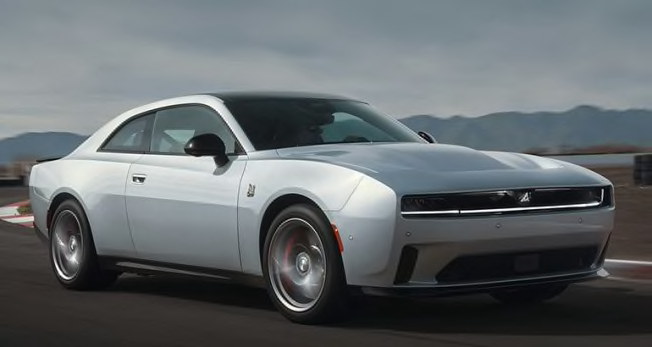
Photo: Dodge Photo: Dodge
CR's Take
The retired Charger sedan and Challenger coupe were both based on a 25-year-old Mercedes-Benz E-Class platform. Yes, it was high time for a redesign.
Dodge took the opportunity to break fresh ground with its next-gen car. Clearly engineers ran with that idea, using the Charger to introduce a new STLA Large platform—a flexible, electric-native setup that can accommodate a variety of powertrain types.
In recent years, electric cars—most notably from Tesla—have redefined performance expectations. Many EVs are stunningly quick, putting even the most potent V8-powered muscle cars to shame with their instant response. More so, they often handle exceptionally well for their class, aided by the low center of gravity provided by the massive, floor-mounted batteries—a trait muscle cars were not traditionally known for.
Translating a muscle car into an EV opens up many possibilities for increased all-around performance. Dodge appears smart in applying this strategy, while simultaneously being cautious by still offering a couple of internal combustion engines.
For many muscle car enthusiasts, nostalgia and rumble is a key part of the experience, not just quarter-mile times. With the EVs, the soundtrack will be simulated.
With both EV and gas-only configurations, sales will be a real-time experiment, revealing today’s buying preferences. And through this, Dodge set itself up to be flexible enough to adapt.
Dodge isn’t alone in scratching the market’s itch for electrified performance: Chevrolet is rumored to be developing its own electric replacement model for the Camaro.
Among the Detroit 3 automakers, only Ford remains committed to purely offering an internal combustion engine in a muscle car with its Mustang.
The muscle car wars have been waged for six decades now, with each automaker vying to bring more horsepower to the battle. Going electric has big advantages, but time will tell if the electrified Charger has enough of that classic spirit to match the unshakeable appeal of traditional cars.
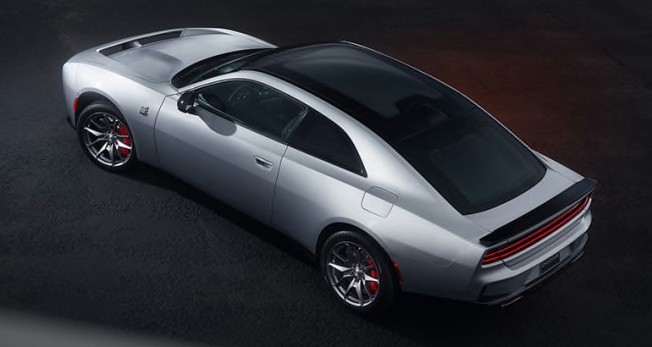
Photo: Dodge Photo: Dodge
Outside
The new Charger has a clear visual connection to the prior coupe (Challenger) and sedan. But the front is quite different, with its bulging and scooped aluminum hood; simplified, horizontal grille; and integrated lighting.
The Charger measures 206.6 inches, bumper to bumper, making it almost 6 inches longer than the 2023 Charger sedan. It rides on a similar wheelbase at 121 inches, and it stands about an inch taller. (The new coupe and sedan share a common wheelbase, unlike before.)
Horizontal LEDs embellish the rear end, much like the outgoing model. More significantly, the Charger is now a hatchback, adding clear versatility to the overall package. Dodge says this allows more cargo space than the previous Charger, although to maximize it, the rear seats do need to be folded forward. Electric models have a small storage compartment under the hood. A panoramic glass top is offered for the first time.
There are eight exterior colors available, including some typically bold choices, and nine available wheel designs can dress up the corners.
Muscle cars have long been known as being a bit hefty, due in large part to the fortified design meant to withstand big power and track abuse, and giant engines. The new Charger Daytona weighs 5,838 pounds, a stunning 1,500 pounds more than the last V8-powered Charger sedan we tested. (That’s 2,000 pounds more than the Mustang GT we are testing now.)
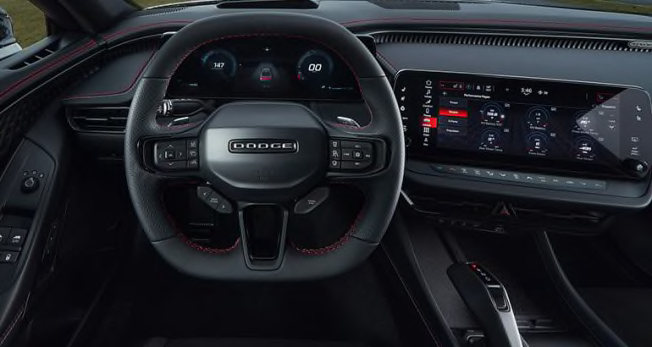
Photo: Dodge Photo: Dodge
Inside
As expected, the cabin is more modern than before, yet the squared-off steering wheel with contrasting stitching makes it look familiar. The instrument cluster is presented on a 10.25- or optional 16-inch display. The infotainment screen is decidedly horizontal and canted toward the driver. Dodge cites that there are design touches throughout intended to evoke the 1968 Charger. Accent lighting can be personalized from among 64 colors, and its intensity relates to various events, such as starting the car or opening the door.
The steering wheel has paddle shifters on electric models to manage the regenerative braking intensity, and there is a Power Shot button on the front to deliver extra energy for rapid acceleration or to fulfill fantasies of driving like Dom Toretto from the Fast and the Furious movies, judiciously applying a nitrous squirt in his 1970 Charger.
The center console features a wireless phone charger. Electric models feature “Daytona” badging.
Standard seats are wrapped in cloth and leatherette (aka faux leather), with available upgrades to include leather, suede, and heat.
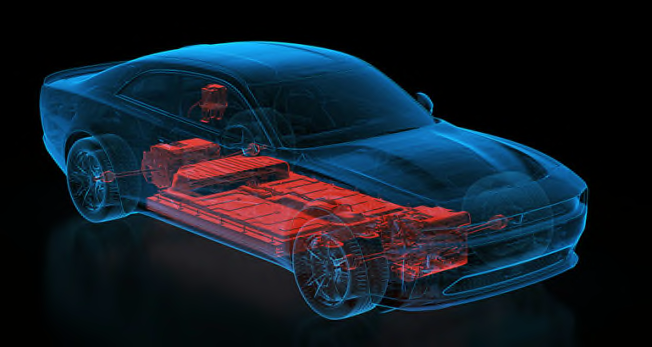
Photo: Dodge Photo: Dodge
What Drives It
The Charger Daytona uses a 400-volt system feeding two electric motors, enabling all-wheel drive. In Mopar fashion, these electric versions are designed to allow multi-stage upgrades. The initial Daytona available at launch comes with a 40-horsepower Stage 1 upgrade good for 456 horsepower and a limited peak of 496 horsepower when using the Power Shot for a 40-hp boost. It has an estimated 317-mile driving range. Dodge pegs its 0 to 60 mph time at 4.7 seconds, with the quarter mile passing in 13.1 seconds. (The last Charger R/T we tested with a V8 took 6.1 seconds to hit 60 mph and 14.5 seconds to reach the quarter-mile mark.)
The Daytona Scat Pack comes with a Stage 2 kit for 630 horsepower and a 260-mile driving range. Output peaks at 670 horsepower when using the Power Shot feature—essentially the electric equivalent to hitting nitrous. Its claimed 0 to 60 mph is 3.3 seconds and the quarter-mile time is 11.5 seconds.
The 100.5-kW nickel-cobalt battery pack has a peak discharge rate of 550 kW to maximize acceleration, say for racing down a quarter-mile track. The automaker states that both cars can be recharged from 20 to 80 percent state-of-charge in about 27 minutes on a DC fast charger.
Performance can be tailored to the driving needs via driver-selectable modes: Drag, Track, Drift, and Donut modes. There is an optional active suspension available on the Charger Daytona Scat Pack with the Track Package designed to rapidly respond to changing road conditions and allow customization via the drive modes.
A faux exhaust sound scales its volume commensurate with performance, ranging from a “stealth” mode up to Hellcat ferocity.
For more traditional customers who favor mechanical sounds, there are two variations of the twin-turbocharged inline-six engine. This “Hurricane” engine has been used in other Stellantis products, such as Jeep SUVs, where it promises lower emissions and better fuel economy than the long-lived Hemi V8 engines it replaces.
The standard output six has 420 horsepower, with the high-output six boasting 550 horsepower. Each is paired with an eight-speed automatic transmission.
For straightline racing, there is a line lock and launch control. Plus, all-wheel drive will certainly aid grip for hard acceleration.
Further aiding traction are the largest tires ever offered by Dodge. Available through a track package, the Charger can be fitted with 20-inch wheels shod with staggered Goodyear Eagle F1 Supercar 3 tires (305/35ZR20 front, 325/35ZR20 rear).

Photo: Dodge Photo: Dodge
Active Safety and Driver Assistance
All versions of the Charger come with automatic emergency braking, blind spot warning, rear cross-traffic warning, lane-keeping assistance, adaptive cruise control, and driver attention monitoring.
Optional features include a surround-view camera, parking sensors, front camera, and blind spot camera that displays on the center screen when the turn signal is activated.
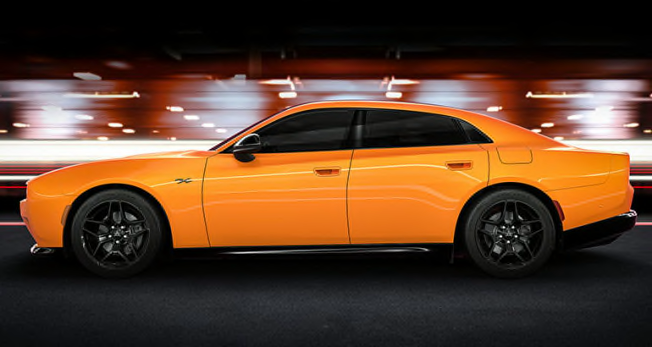
Photo: Dodge Photo: Dodge





















